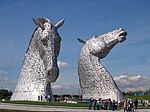The Kelpies

The Kelpies are 30-metre-high (98 ft) horse-head sculptures depicting kelpies, located between Falkirk and Grangemouth, but the Kelpies themselves are situated in Grangemouth, standing next to an extension to the Forth and Clyde Canal, and near the River Carron, in The Helix, a parkland project built to connect sixteen communities in the Falkirk Council Area, Scotland. The sculptures were designed by sculptor Andy Scott and were completed in October 2013. The sculptures form a gateway at the eastern entrance to the Forth and Clyde canal, and the canal extension built as part of The Helix land transformation project. For a short time, they were the tallest equine statues in the world until Pegasus and Dragon was completed the following year. The sculptures were opened to the public in April 2014. As part of the project, they have their own visitors‘ centre, and sit beside a newly developed canal turning pool and extension. This canal extension reconnects the Forth and Clyde Canal with the River Forth, and improves navigation between the East and West of Scotland.
Excerpt from the Wikipedia article The Kelpies (License: CC BY-SA 3.0, Authors, Images).The Kelpies
Forth and Clyde Canal Towpath,
Geographical coordinates (GPS) Address External links Nearby Places Show on map
Geographical coordinates (GPS)
| Latitude | Longitude |
|---|---|
| N 56.0191 ° | E -3.7553 ° |
Address
The Kelpies
Forth and Clyde Canal Towpath
FK2 7ZT
Scotland, United Kingdom
Open on Google Maps










